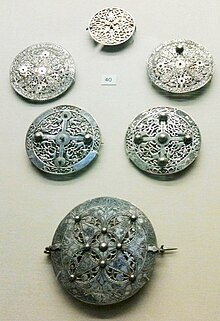Human settlement in England
| Pentney | |
|---|---|
 Pentney village sign in the midst of a rare springtime snowfall during 2008 Pentney village sign in the midst of a rare springtime snowfall during 2008 | |
 | |
| Area | 10.39 km (4.01 sq mi) |
| Population | 544 (2011) |
| • Density | 52/km (130/sq mi) |
| OS grid reference | TF720138 |
| Shire county | |
| Region | |
| Country | England |
| Sovereign state | United Kingdom |
| Post town | KING'S LYNN |
| Postcode district | PE32 |
| Dialling code | 01760 |
| Police | Norfolk |
| Fire | Norfolk |
| Ambulance | East of England |
| 52°41′40″N 0°32′37″E / 52.694562°N 0.543727°E / 52.694562; 0.543727 | |
Pentney is a village and civil parish in the English county of Norfolk, located about 8 miles (13 km) south east of King's Lynn placing it about halfway between King's Lynn and Swaffham on the A47 road. It covers an area of 10.39 km (4.01 sq mi) and had a population of 387 in 184 households at the 2001 census, increasing to 544 at the 2011 Census. For the purposes of local government, it falls within the district of King's Lynn and West Norfolk. It is in the valley of the River Nar, a tributary of the River Great Ouse.
The age of the village is unknown, but it dates at least to the 3rd or 4th centuries CE, from which time there is evidence of a Romano-British local pottery industry. A Roman road and settlement in Pentney ran close to the river Nar The name suggests that Pentney was at one time an island: one theory for the etymology is Penta's / Penda's Island, from the Anglo-Saxon Pendan-ig, the ig being equivalent to Old Norse ey = island (Pentney is on drained waterlands).
History
Augustinian Priory

About a mile west of the village, on the north bank of the River Nar, is the gatehouse, all that remains of the Augustinian Pentney Priory, also known as Priory of the Holy Trinity, St Mary and St Magdalene, established around 1130. It was founded by Robert de Vaux, one of the Norman nobles who came to England with William I. on lands that had belonged to Hacon the Dane, evicted by William. De Vaux installed a number of Augustine Canons to come and settle at Pentney to pray for the souls of him and his family. It soon established itself, and continued for centuries, as a significant and prosperous presence in Pentney for its farming and teaching activities.
The gatehouse itself – "the finest in Norfolk and a smaller copy of that at Thornton Abbey" – dates from the 14th century and is a three-storey multi-unit lodging built of flint rubble with Barnack stone dressing.
A number of members of aristocratic families are known to have been buried at the Priory: Maud, wife of William de Ros; Petronilla de Nerford (died 1326) and John de Nerford (died 1328).
Pentney Priory became the centre of a religious and political controversy in the 1160s when Hugh Bigod, 1st Earl of Norfolk, took the opportunity during the anarchic reign of King Stephen to seize its considerable lands, claiming the right under a weakness in the details of a property agreement between his father and Roger de Vaux. Geoffrey, the Prior of Pentney, took the case to the Pope, and when it finally was dealt with, in the reign of Henry II, Bigod was excommunicated by the Pope, who imposed an interdict on the earldom. This created a tension between Henry, who opposed the interdict, and the Bishops of London and Norwich, who with the support of Thomas Becket were expected to enforce it.
In 1280, Archbishop John Peckham conducted a stringent visitation of the Priory as part of a crackdown on misconduct at religious institutions in the Norwich diocese. Pentney and its Canons were found without fault.
The Priory went in decline in the 15th century and consolidated with Wormegay priory in 1468. Pentney Priory was finally closed during the Dissolution of the Monasteries under Henry VIII, who had the Priory shut down in February 1537, and its estate and properties sold to Thomas Manners, the Earl of Rutland.
Stone from the Priory has been used in Abbey Farm and Little Abbey Farm. Many of the houses and outbuildings in Pentney also contain Barnack stone taken from the Abbey.
Wayside Cross

Between the village and the Priory are the remains of a wayside cross; the cross having been broken off in historical times, only the plinth and pillar remain. A correspondent to Notes and Queries wrote of it: "We find the pedestal and shaft of what must have been, when perfect, a most handsome cross, it all seems in such perfect proportion. The shaft is remarkably slender, even for a wayside cross".
Pentney Church

The church of St Mary Magdalene has stood on this site since Norman times and was originally built as a small chapel with an apse. It was doubled in length in the 13th or 14th century.
Pentney Treasure

In 1978, an East Dereham gravedigger, William King, found six silver Saxon brooches while digging a grave at the church. Not realising what they were, he handed them to the rector, who locked them in the vestry chest. Three years later the new rector, the Rev. John Wilson, recognised their significance, and they were subsequently identified by the British Museum as 9th century silver disc brooches of national importance, made of delicately cut and engraved sheet silver.
An inquest declared the items as treasure trove and the property of the Crown. Mr King was given the value of the brooches, £135,000. He donated £25,000 to Pentney church, and the brooches can now be viewed at the British Museum.
Transport
Pentney was formerly served by the Narborough and Pentney railway station on the Lynn and Dereham Railway. The line was opened in 1846–8 and closed in September 1968 as part of the Beeching Axe. Currently, the only remaining public transport links to the village are an infrequent bus service which operates in the morning only.
The River Nar is not navigable but was temporarily made so in the 1750s. Authorised by an Act of 1751, the river was opened for barge traffic, with ten staunches constructed, from King's Lynn to Narborough, a little east of Pentney. River traffic ceased in 1884.
Pentney Poacher
Pentney was the birthplace of the well-known 'King of the Norfolk Poachers'. The Pentney Poacher's story is told in the East Anglian classic I Walked by Night. More recently a short documentary follows the story and identity of the poacher, said to be Fred Rolfe who ended his life by suicide in Bungay, Suffolk.
Governance
Pentney is a parish of the Kings Lynn and West Norfolk district council, which is responsible for the most local services. Norfolk County Council is responsible for roads, some schools and social services. For Westminster elections the parish forms part of the North West Norfolk constituency, represented by James Wild (Conservative).
References
- Census population and household counts for unparished urban areas and all parishes Archived 11 February 2017 at the Wayback Machine. Office for National Statistics & Norfolk County Council (2001). Retrieved 20 June 2009.
- "Parish population 2011". Retrieved 29 August 2015.
- Norfolk, Part 1, Buildings of England, Pevsner architectural guides: Norfolk, Nikolaus Pevsner and Bill Wilson, Yale University Press, 2002, ISBN 0-300-09607-0
- Aslet Clive, 2011, Villages of Britain, p263. Bloomsbury publishing.
- p.70, Surnames of the United Kingdom: A Concise Etymological Dictionary, Henry Harrison, 1912; reprinted 1996, Genealogical Publishing Com, ISBN 0-8063-0171-6
- "Pentney Priory Saved for the Nation | Historic England". 11 March 2014.
- ^ The Priory of Pentney, from A History of the County of Norfolk: Volume 2, ed. William Page, 1906: reprint at British History Online
- ^ Studies by a recluse, in cloister, town, and country, Augustus Jessopp, 1893: Ayer Publishing reprint, 1969, ISBN 0-8337-1841-X.
- ^ pp101-102, Greater Medieval Houses of England and Wales, 1300–1500: East Anglia, Central England, and Wales, Anthony Emery, Cambridge University Press, 2000, ISBN 0-521-58131-1. Google Books
- Late Medieval Monasteries and their Patrons: England and Wales, c.1300–1540, Volume 29 of Studies in the history of medieval religion, Karen Stöber, Boydell Press, 2007, ISBN 1-84383-284-4.
- p139, Thomas Becket, Frank Barlow, University of California Press, 1990, ISBN 0-520-07175-1.
- ^ Pentney Priory, English Heritage Pastscape site.
- East Anglian Archaeology, Issue 45, Report (Chelmsford Archaeological Trust), Norfolk Archaeological Unit, Norwich Survey, pub. Norfolk Archaeological Unit, 1988
- Pentney Little Abbey Farm information leaflet 2004.
- GL Gomme, Notes and queries, Oxford University Press, 1880
- The Post Office Directory of the Counties of Cambridge, Norfolk and Suffolk, ER Kelly, 1879
- St Mary Magdalene, Pentney, A Church Near You, official Church of England site.
- £135,000 for treasure finder, The Times, Friday, 17 October 1980.
- Six disc brooches from the Pentney hoard, Highlights, British Museum online
- Industrial archaeology, Volume 7, Newcomen Society (Great Britain), David and Charles, 1971
- Lilias Rider Haggard, 1935, I Walked By Night, Ivor Nicholson & Watson, London.
- DVD, Hodges & Paton, C, 2010, The truth behind I Walked by night, Broad Sky Publications.
External links
![]() Media related to Pentney at Wikimedia Commons
Media related to Pentney at Wikimedia Commons